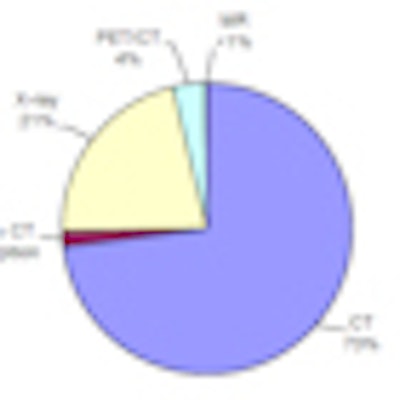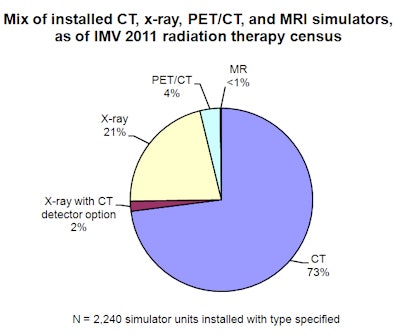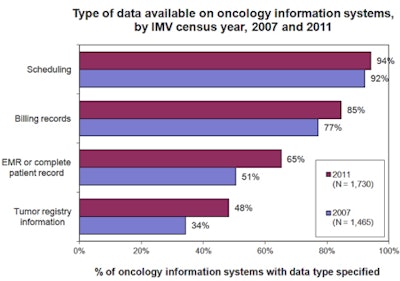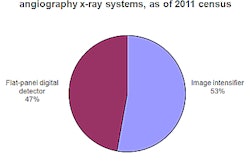
Radiation therapy treatment visit volume in 2010 in the U.S. appears to have bounced back to 2007 levels. Patients made 20.8 million treatment visits that year, after dips in the number of visits in 2008 and 2009, according to a report from market research firm IMV Medical Information Division.
Combined with 5.5 million allied (nontreatment) visits, the 2010 figure represents an approximate 7% increase in total visits compared to 2007. The new IMV report summarizes the results of 664 interviews and projects them to a universe of 2,290 sites performing radiation therapy treatments. All participating sites use external-beam therapy equipment, dedicated radiosurgery systems, or brachytherapy.
"The average treatment visits per site are up, but not at the same level they were in 2007," said Lorna Young, senior director of market research at IMV. "The [rise] is due in part to the increase of identified sites that are doing the treatments."
Courses of treatment totaled 924,150 in 2010, down a slight 3% compared to 2007, meaning fewer patients received radiation therapy in 2010. "This would indicate that slightly more treatment visits are being performed per patient than ... before," Young said.
Breast studies have increased from 20% of the total courses of treatment in 2007 to 24% in 2010, which is partly attributable to the earlier identification and treatment of breast cancer.
In addition to breast cancer, the cancer types that are treated at 90% or more of the facilities include head and neck, prostate, and lung, as well as bone metastases and brain metastases, according to the IMV report.
Integrating digital imaging
The 2011 survey indicates that 76% of the radiation therapy sites provide image-guided radiotherapy (IGRT), up from 15% of the sites in the 2004 census. The proportion of IGRT systems using CT (or conebeam CT) for image guidance has increased, while the proportion using ultrasound or electronic portal imaging has declined.
The proportion of sites with CT simulators was approximately one-third in 2003; today almost three-fourths of the sites report having them.
 |
| Source: IMV 2011 Radiation Therapy Market Summary Report |
In addition, the use of PET as part of the treatment plan for breast cancer and cancer in general has given a boost in the marketplace. The proportion of sites that use PET at least some of the time has gone from 30% in 2004 to 77%. MR use has gone from 48% to 79% over the same period.
Replacement and growth
Of the sites surveyed, one-third are planning to purchase a new external-beam therapy system over the next three years, including linear accelerators and TomoTherapy, CyberKnife, and proton therapy technology. Three-quarters of planned purchases will be replacement units. The median age of the installed base of external-beam units is 7 years, with more than half of the units having been installed in 2005 or later.
Growth in the marketplace will be linked to the demographics of an aging population, according to Young. As the population ages, more cancer cases will likely be identified and need imaging to precisely target radiation therapy.
"The use of imaging to diagnose cancers, generate radiation therapy treatment plans, simulate the procedure, and track patient progress has helped improve radiation therapy's effectiveness as a treatment option," Young said. "People will continue to seek more precision in their ability to target as well as treat any cancers, whether using one technique or another. The goal is to excise it as precisely as possible."
Oncology information systems
To track and document patient progress, nearly all the radiation therapy sites have a "record and verify" and/or oncology information system installed. The top information types available on oncology information systems include scheduling, billing, electronic medical record (EMR), and tumor registries.
In 2007, approximately half of respondents said they had an EMR connected to their oncology information systems.
 |
| Source: IMV 2011 Radiation Therapy Market Summary Report |
"And going forward, of the people planning to buy or upgrade their information system, some 80% are planning to have EMR interfaced or integrated with their oncology information system," Young said. "This is definitely a growth area. The use of EMR across the healthcare enterprise and the need to integrate radiation therapy patient information with the EMR is a key priority."
Disclosure notice: AuntMinnie.com is owned by IMV, Ltd.



















